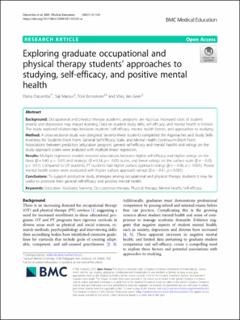| dc.contributor.author | DaLomba, Elaina | |
| dc.contributor.author | Mansur, Saji | |
| dc.contributor.author | Bonsaksen, Tore | |
| dc.contributor.author | Greer, Jan | |
| dc.date.accessioned | 2021-07-29T10:13:47Z | |
| dc.date.available | 2021-07-29T10:13:47Z | |
| dc.date.created | 2021-02-02T08:27:11Z | |
| dc.date.issued | 2021 | |
| dc.identifier.citation | BMC Medical Education. 2021, 21:124, 1-8. | en_US |
| dc.identifier.issn | 1472-6920 | |
| dc.identifier.uri | https://hdl.handle.net/11250/2765594 | |
| dc.description | This article is licensed under a Creative Commons Attribution 4.0 International License, which permits use, sharing, adaptation, distribution and reproduction in any medium or format, as long as you give appropriate credit to the original author(s) and the source, provide a link to the Creative Commons licence, and indicate if changes were made. The images or other third party material in this article are included in the article's Creative Commons licence, unless indicated otherwise in a credit line to the material. If material is not included in the article's Creative Commons licence and your intended use is not permitted by statutory regulation or exceeds the permitted use, you will need to obtain permission directly from the copyright holder. | en_US |
| dc.description.abstract | Background
Occupational and physical therapy academic programs are rigorous. Increased rates of student anxiety and depression may impact learning. Data on student study skills, self-efficacy, and mental health is limited. This study explored relationships between students’ self-efficacy, mental health factors, and approaches to studying.
Method
A cross-sectional study was designed. Seventy-three students completed the Approaches and Study Skills Inventory for Students-Short Form, General Self-Efficacy Scale, and Mental Health Continuum-Short Form. Associations between predictors (education program, general self-efficacy and mental health) and ratings on the study approach scales were analyzed with multiple linear regression.
Results
Multiple regression models revealed associations between higher self-efficacy and higher ratings on the deep (β = 0.49, p < 0.01) and strategic (β = 0.34, p < 0.05) scales, and lower ratings on the surface scale (β = − 0.29, p < 0.01). Compared to OT students, PT students had higher surface approach ratings (β = − 0.36, p < 0.001). Poorer mental health scores were associated with higher surface approach ratings (β = − 0.41, p < 0.001).
Conclusions
To support productive study strategies among occupational and physical therapy students it may be useful to promote their general self-efficacy and positive mental health. | en_US |
| dc.language.iso | eng | en_US |
| dc.rights | Navngivelse 4.0 Internasjonal | * |
| dc.rights.uri | http://creativecommons.org/licenses/by/4.0/deed.no | * |
| dc.title | Exploring graduate occupational and physiotherapy students’ approaches to studying, self-efficacy, and positive mental health | en_US |
| dc.type | Peer reviewed | en_US |
| dc.type | Journal article | en_US |
| dc.description.version | publishedVersion | en_US |
| dc.rights.holder | © The Author(s). 2021. | en_US |
| dc.source.pagenumber | 1-8 | en_US |
| dc.source.volume | 21 | en_US |
| dc.source.journal | BMC Medical Education | en_US |
| dc.identifier.doi | 10.1186/s12909-021-02550-w | |
| dc.identifier.cristin | 1885646 | |
| dc.source.articlenumber | 124 | en_US |
| cristin.ispublished | false | |
| cristin.fulltext | original | |
| cristin.qualitycode | 1 | |

